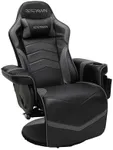Buying Guide for the Best Gaming Chair
Choosing the right gaming chair can make a big difference in your comfort and overall gaming experience. A good chair supports your posture, helps you stay comfortable during long sessions, and can even help prevent back pain. When shopping for a gaming chair, it's important to look beyond just the style and color. Focus on features that match your body type, how long you plan to sit, and the kind of support you need. Understanding the key specifications will help you find a chair that fits you well and keeps you comfortable.ErgonomicsErgonomics refers to how well the chair supports your body, especially your back, neck, and arms. This is important because a chair with good ergonomics can help prevent discomfort and long-term health issues. Chairs with adjustable lumbar support, headrests, and armrests are considered more ergonomic. If you spend many hours gaming, look for a chair with multiple adjustment options so you can fine-tune the fit to your body. For shorter sessions, basic ergonomic features may be enough.
AdjustabilityAdjustability means how much you can change the chair to fit your preferences. This includes seat height, armrest position, recline angle, and tilt tension. High adjustability is important if you want a personalized fit or if multiple people will use the chair. If you are taller or shorter than average, or if you like to change positions often, look for a chair with more adjustment options. If you prefer a simple setup, basic adjustments may be sufficient.
Build Quality and MaterialsBuild quality and materials affect how long the chair will last and how comfortable it feels. Common materials include PU leather, fabric, and mesh. PU leather is easy to clean and looks sleek, but may get hot after long use. Fabric is more breathable but can stain more easily. Mesh is very breathable and good for hot climates, but may not feel as plush. The frame should be sturdy, usually made of metal or strong plastic. If you want a chair that lasts for years, pay attention to the quality of both the frame and the upholstery.
Weight Capacity and SizeWeight capacity tells you the maximum weight the chair can safely support, while size refers to the dimensions of the seat and backrest. This is important for both safety and comfort. Chairs come in different sizes to fit different body types. If you are taller, heavier, or have a larger build, look for a chair with a higher weight capacity and a wider seat. If you are smaller, a more compact chair may fit you better and feel more supportive.
Cushioning and PaddingCushioning and padding determine how soft and comfortable the chair feels. Some chairs have thick, firm padding that provides strong support, while others have softer, plush padding for a more relaxed feel. If you plan to sit for long periods, firmer padding can help prevent discomfort and maintain support. If you prefer a softer seat for shorter sessions, look for chairs with more plush padding. Your personal comfort preference should guide your choice here.
Recline and Rocking FeaturesRecline and rocking features let you lean back or rock in the chair, which can help you relax between games or find a more comfortable position. Some chairs recline almost flat, while others only tilt slightly. If you like to lean back or take breaks in your chair, look for a model with a wide recline range and a locking mechanism. If you prefer to sit upright, a basic tilt function may be enough.
ArmrestsArmrests support your arms and help reduce strain on your shoulders and neck. They can be fixed or adjustable in height, width, and angle. Adjustable armrests are useful if you want to match the chair to your desk height or your body size. If you spend a lot of time typing or using a controller, good armrest support can make a big difference in comfort.
















